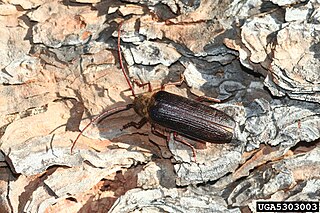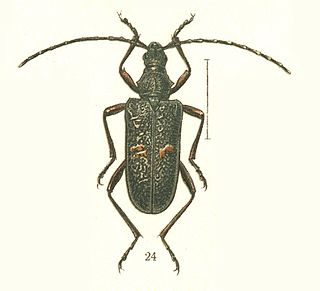
Eucinetidae is a family of beetles, notable for their large coxal plates that cover much of the first ventrite of the abdomen, sometimes called plate-thigh beetles. The family is small for beetles, with about 50 species in 11 genera, but are found worldwide.

Fire-coloured beetles are the beetles of the Pyrochroidae family, which includes the red cardinal beetles. This family contains some 150 species. Many species in the subfamily Pyrochroinae have comb- or antler-like antennae. This family also now includes most former members of the defunct family Pedilidae.

Geotrupes is a genus of earth-boring scarab beetles in the family Geotrupidae. There are at least 30 described species in Geotrupes.

Mononychus is a genus of minute seed weevils in the family of beetles known as Curculionidae. There are at least 20 described species in Mononychus.

Larinus is a genus of true weevils, comprising about 180 species, mostly in the Palaearctic region. Turkey appears to have a significant diversity of the group, with more than 50 species recorded in the Eastern part of the country.
Beetles of the genus Helichus are found worldwide apart from in Australia and Antarctica. Adults reach 1–8 millimetres (0.04–0.31 in) long and live in aquatic or riparian environments. The larvae are land-dwelling which may be unique in water living insects.

Tragosoma is a genus of beetles in the longhorn beetle family, Cerambycidae.

Xestoleptura is a genus of flower longhorn beetles in the family Cerambycidae.

Sachalinobia is a genus of flower longhorns in the beetle family Cerambycidae. There are at least two described species in Sachalinobia.
Ulochaetes is a genus of long-horned beetles in the family Cerambycidae. There are at least two described species in Ulochaetes.

Poecilium is a genus of long-horned beetles in the family Cerambycidae. There are at least 20 described species in Poecilium.

Neoclytus is a genus of beetles in the family Cerambycidae, containing the following species:

Hesperophanes is a genus of long-horned beetles in the family Cerambycidae. There are about eight described species in Hesperophanes.

Trichoferus is a genus of long-horned beetles in the family Cerambycidae. There are at least 20 described species in Trichoferus.

Phaedon is a genus of Chrysomelinae.

Tetropium is a genus of long-horned beetles in the family Cerambycidae. There are at least 20 described species in Tetropium.

Atimia is a genus of long-horned beetles in the family Cerambycidae. There are about 13 described species in Atimia.
Cryptocephalus sanguinicollis is a species of case-bearing leaf beetle in the family Chrysomelidae. It is found in Central America and North America.
Pachylobius is a genus of pine weevils in the beetle family Curculionidae. There are at least two described species in Pachylobius.
















